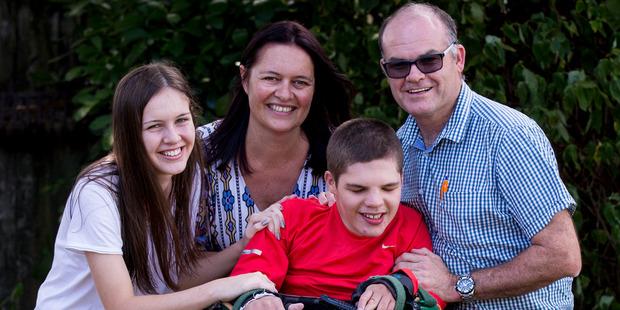James Wilson, a 14 year old in New Zealand, suffers from Lennox-Gastaut syndrome. It’s a form of epilepsy which left him disabled, and as a result, he needs to wear orthotic molds on his feet to help him walk.
The molds were hot, uncomfortable, and expensive – at least until now. James’ father, Dr. Douglas Wilson, is a senior lecturer and the head of Auckland University’s transportation engineering group, and it pained him to see his son’s discomfort. So the elder Wilson decided to come up with a way to free his son from the splints he’d been forced to wear for the last 10 years.

James Wilson, with sister Miriama and parents Puti and Doug Wilson, was the inspiration for a set of more comfortable, cheaper, and faster-to-produce 3D printed orthotic splints. Photo by Dean Purcell.
As it stood, the splints took three months to be custom made in the United States – and they cost a whopping $1,000 a pair. So Dr. Wilson contacted pediatric neurologist Dr. Rakesh Patel with an idea to solve the problem.
The result of their collaboration, working in conjunction with Professor Xun Xu, a professor and lecturer on 3D printing, was a brace that was better, cheaper, and faster to make aimed at providing disabled children a better hope of walking in comfort. They call it the Smart Splint, and the molds used to produce it cost just $50 – and take just a single day — to produce. The splints help realign a child’s feet and promote easier movement.
The splints are now set to undergo clinical trials with the support of four universities, and the team hope to patent and commercialize the technology to print prosthetic legs for amputees worldwide as well.
A neurologist at Starship Hospital, Dr. Patel and Wilson came up with the idea 18 months ago, and they created four prototypes as proofs of concept for children with cerebral palsy, muscular dystrophy, and other disabilities.
18 months ago, and they created four prototypes as proofs of concept for children with cerebral palsy, muscular dystrophy, and other disabilities.
“With cerebral palsy, because of their neurological problem their feet go in odd shapes because the muscles pull in different directions,” Dr. Patel says. “It means they can’t walk properly so what we try to do is correct the position. It improves the chances of walking and getting them upright and more mobile.”
Dr. Patel said the splints can be used to help people with stroke, spinal cord injury, polio, multiple sclerosis, peripheral neuropathy, arthritis, and even perhaps even broken bones.
Engineering student Ella Meisel and her project partner, student Phillip Daw, joined the team and spent a year developing the process.
Clinical trials will be completed by engineering graduate students, and they hope to have results within the next six months.
The Smart Splints are made by creating electronic scans or using photographs of the affected limb, a mold is printed which represents an exact fit from the digital splint, and the splints are then 3D printed.
What do you think of these Smart Splints? Do you know of any other projects now underway that use 3D printing and design to solve medical problems? Let us know in the 3D Printed Smart Splints forum thread on 3DPB.com.
Subscribe to Our Email Newsletter
Stay up-to-date on all the latest news from the 3D printing industry and receive information and offers from third party vendors.
You May Also Like
3D Printing Unpeeled: Biofuel Waste to Filament & Sustainable Photopolymers
I can’t ever remember a day with so many potentially high impact news stories have come out. In one story, we all know that there are problems with the safety...
Finnair Hires AM Craft to 3D Print Plastic Parts for Aircraft Interiors
Riga-based AM Craft, a supplier specialized in 3D printing aviation components and certified under EASA Part 21G, announced a significant achievement today. The company will assist in upgrading Finnair’s A320...
3DPOD Episode 198: High Speed Sintering with Neil Hopkinson, VP of AM at Stratasys
Neil Hopkinson, a pioneering 3D printing researcher, played a pivotal role in developing a body of research that is widely utilized today. He also invented High Speed Sintering (HSS), also...
3D Printing Webinar and Event Roundup: May 12, 2024
Webinars and events are picking up in the AM industry this week! ASTM International continues its Professional Certificate Course and Stratasys continues its advanced in-person trainings, while 3D Systems is...
































